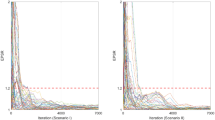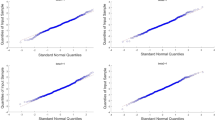Abstract
The proportional hazards (PH) model is the most widely used semiparametric regression model for analyzing right-censored survival data based on the partial likelihood method. However, the partial likelihood does not exist for interval-censored data due to the complexity of the data structure. In this paper, we focus on general interval-censored data, which is a mixture of left-, right-, and interval-censored observations. We propose an efficient and easy-to-implement Bayesian estimation approach for analyzing such data under the PH model. The proposed approach adopts monotone splines to model the baseline cumulative hazard function and allows to estimate the regression parameters and the baseline survival function simultaneously. A novel two-stage data augmentation with Poisson latent variables is developed for the efficient computation. The developed Gibbs sampler is easy to execute as it does not require imputing any unobserved failure times or contain any complicated Metropolis-Hastings steps. Our approach is evaluated through extensive simulation studies and illustrated with two real-life data sets.




Similar content being viewed by others
References
Banerjee T, Chen MH, Dey DK, Kim S (2007) Bayesian analysis of generalized odds-rate hazards models for survival data. Lifetime Data Anal 13:241–260
Cai B, Lin X, Wang L (2011) Bayesian proportional hazards model for current status data with monotone splines. Comput Statist Data Anal 55:2644–2651
Cai T, Betensky RA (2003) Hazard regression for interval-censored data with penalized spline. Biometrics 59:570–579
Cox D (1972) Regression models and life tables (with discussion). J Royal Statist Soc Ser B 34:187–220
Cox D (1975) Partial likelihood. Biometrika 62:269–276
Finkelstein DM (1986) A proportional hazards model for interval-censored failure time data. Biometrics 42:845–854
Gelfand AE, Smith AFM (1990) Sampling-based approaches to calculating marginal densities. J Am Statist Assoc 85:398–409
Geman S, Geman D (1984) Stochastic relaxiation, Gibbs distributions, and the Bayesian restoration of images. IEEE Trans Pattern Anal Mach Intel 6:721–741
Gilks W, Wild P (1992) Adaptive rejection sampling for Gibbs sampling. Appl Statist 41:337–348
Goedert J, Kessler C, Adedort L, Biggar R, Andes W, White G, Drummond J, Vaidya K, Mann D, Eyster M et al (1989) A progressive-study of human immunodeficiency virus type-1 infection and the development of AIDS in subjects with hemophilia. New Engl J Med 321:1141–1148
Goggins W, Finkelstein DM, Schoenfeld DA, Zaslavsky M (1998) A Markov chain Monte Marlo EM algorithm for analyzing interval-censored data under the Cox proportional hazards model. Biometrics 54:1498–1507
Gomez G, Calle ML, Oller R, Langohr K (2009) Tutorial on methods for interval-censored data and their implementation in R. Statist Model 9:259–297
Heller G (2011) Proportional hazards regression with interval censored data using an inverse probability weight. Lifetime Data Anal 17:373–385
Henschel V, Heiß C, Mansmann U (2009a) The intcox package. Comprehensive R archive network
Henschel V, Heiß C, Mansmann U (2009b) survBayes: A introduction into the package. Comprehensive R archive network.
Ibrahim JG, Chen MH, Sinha D (2001) Bayesian survival analysis. Springer, New York
Joly P, Commenges D, Letenneur L (1998) A penalized likelihood approach for arbitrarily censored and truncated data: application to age-specific incidence of dementia. Biometrics 54:185–194
Kroner B, Rosenberg P, Adedort L, Alvord W, Goedert J (1994) HIV-1 infection incidence among people with hemophilia in the United States and Western Europe, 1978–1990. J Acquired Immune Defic Syndr 7:279–286
Lin X, Wang L (2010) A semiparametric Probit model for case 2 interval-censored failure time data. Statist Med 29:972–981
Lin X, Wang L (2011) Bayesian proportional odds models for analyzing current status data: univariate, clustered, and multivariate. Commun Statist Simul Comput 40:1171–1181
Pan W (1999) Extending the iterative convex minorant algorithm to the Cox model for interval-censored data. J Comput Graph Statist 8:109–120
Pan W (2000) A multiple imputation approach to Cox regression with interval-censored data. Biometrics 56:199–203
Park T, Casella G (2008) The Bayesian Lasso. J Am Statist Assoc 103:681–686
Plummer M, Best N, Cowles K, Vines K (2006) CODA: convergence diagnosis and output analysis for MCMC. R News 6:7–11
Ramsay JO (1988) Monotone regression splines in action. Statist Sci 3:425–441
Rabinowitz D, Betensky RA, Tsiatis AA (2000) Using conditional logistic regression to fit proportional odds models to interval censored data. Biometrics 56:511–518
Robert CP, Casella G (2004) Monte Carlo statistical methods. Springer, New York
Satten GA (1996) Rank based inference in the proportional hazards model for interval-censored data. Biometrika 83:355–370
Satten GA, Datta S, Williamson JM (1998) Inference based on imputed failure times for the proportional hazards model with interval-censored data. J Am Statist Assoc 93:318–327
Sinha D, Chen MH, Ghosh SK (1999) Bayesian analysis and model selection for interval-censored survival data. Biometrics 55:585–590
Spiegelhalter DJ, Best NG, Carlin BP, van der Linde A (2002) Bayesian measures of model complexity and fit (Pkg: P583–639). J Royal Statist Soc Ser B 64:583–616
Sun J (2006) The statistical analysis of interval-censored data. Springer, New York
Wang L, Dunson DB (2011) Semiparametric Bayes proportional odds models for current status data with under-reporting. Biometrics 67:1111–1118
Wang L, Lin X (2011) A Bayesian approach for analyzing case 2 interval-censored failure time data under the semiparametric proportional odds model. Statist Probab Lett 81:876–883
Wang X, Chen MH, Yan J (2013) Bayesian dynamic regression models for interval censored survival data with application to children dental health. Lifetime Data Anal 19:297–316
Wang X, Yan J, Chen MH (2013) The dynsurv package. Comprehensive R archive network
Yavuz AC, Lambert P (2011) Smooth estimation of survival functions and hazard ratios from interval-censored data using Bayesian penalized B-splines. Statist Med 30:75–90
Zeng D, Cai J, Shen Y (2006) Semiparametric additive risks model for interval-censored data. Statistica Sinica 16:287–302
Zhang Y, Hua L, Huang J (2010) A spline-based semiparametric maximum likelihood estimation method for the Cox model with interval-censored data. Scandinavian J Statist 37:338–354
Zhang ZG, Sun J (2010) Interval censoring. Statist Methods Med Res 19:53–70
Zhang ZG, Sun L, Zhao X, Sun J (2005) Regression analysis of interval-censored failure time data with linear transformation models. Can J Statist 33:61–70
Author information
Authors and Affiliations
Corresponding author
Rights and permissions
About this article
Cite this article
Lin, X., Cai, B., Wang, L. et al. A Bayesian proportional hazards model for general interval-censored data. Lifetime Data Anal 21, 470–490 (2015). https://doi.org/10.1007/s10985-014-9305-9
Received:
Accepted:
Published:
Issue Date:
DOI: https://doi.org/10.1007/s10985-014-9305-9




